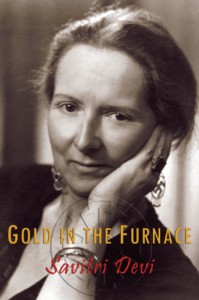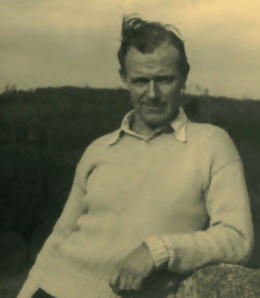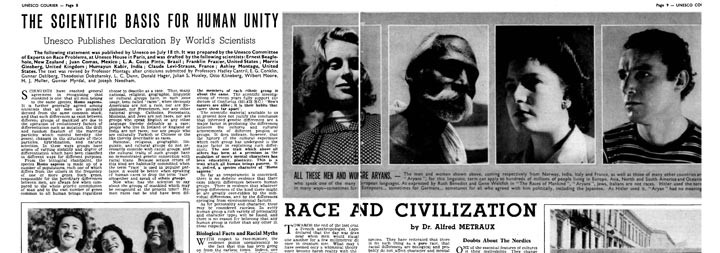Remembering William Gayley Simpson (July 23, 1892–December 31, 1990) A Pleasant Afternoon with Harriet and Bill Simpson
Back in 1986, my friend Fritz Berg[1] was suddenly inspired to drive 100 miles north into Upstate New York — Fritz lived in Fort Lee, New Jersey, across the George Washington Bridge — and drop in on William Gayley Simpson.
This was more than a joyride, and I suppose it wasn’t all that sudden; Fritz had some kind of agenda in the works. Bill was getting old — about 94 at the time — and there was talk about him and his wife moving north to Cooperstown, New York, mainly for health reasons. Cooperstown (population 1,820), founded by James Fenimore Cooper’s father, had everything — or at least it had doctors, as well as arts festivals and, of course, baseball. It was a major metropolis compared with where the Simpsons were living then, which was basically the middle of nowhere, in a rambling old house in the woods.
The place didn’t even have a name, so far as I knew. A year ago I finally researched it and found that there was a tiny hamlet down the road calling itself Prattsville (population 700). But Prattsville is in fact a “town”; i.e., a subdivision of Greene County, New York — not a village at all, but rather what in other states might be called a township. Thus, it was a town with 700 people over 20 square miles, an area about the size of Manhattan. And that’s where Harriet and Bill Simpson lived, at the edge of a forest in the northern Catskills. It’s also where Bill ended up being buried in 1990, after dying in hospital in Cooperstown.
Digging a little deeper, I learned that Bill had been given this house, with attached farm and woodlands, way back in 1932. Yes, he was given it, the way you might give away your spare copy of Which Way Western Man? (about which, more later). Bill had once been a Presbyterian minister, but he became disenchanted with Christianity after reading Friedrich Nietzsche, so he defrocked himself and became instead a professional lecturer and Seeker After Truth. He did the whole Razor’s Edge trip, traveling to India and the Far East, meeting gurus and mystics, ever searching after the meaning of existence. Having never had any interest in gurus and mystics, I found these accounts more otherworldly than intriguing.[2]
As another churchman wrote of Bill in 1934:
He longed to live close to the earth, away from the madness of cities, and to grow his own food with his own hands. And it was at this time that a friend, knowing of his need, gave him a farm near Prattsville, New York, high up in the Catskill Mountains.[3]
I love this story. Anybody got a spare farm you don’t need? A newspaper clipping from 1935 says that Bill “bought” the house and acreage from one Gordon E. Becker, but this may reflect a simple formality of deed transfer.
Regardless, here we were 54 years later, and Bill had to figure out what to do about the property. His wife was much younger, but she wasn’t about to remain in that house by herself, an elderly widow alone in the woods, high up in the Catskills. So now Bill was thinking along eleemosynary lines: He ought to give the house and land to a charity, or a foundation, or something like that. Bill had had at least one child from his earlier marriages (I count at least two wives before Harriet, whom he married in 1965), but the child or children never seemed to be in the picture, and there was no talk about leaving the Prattsville farm to the whelps.
All of which brings us back to the subject of Fritz Berg. Fritz was floating some scheme about turning Bill’s house into a writer’s retreat. The idea is that we’d set up some not-for-profit, choose some candidates willing to live at our little mountain Yaddo, and Bill would make the property over to the foundation’s board. We had a mutual friend who’d lived for a couple of years on a private buffalo preserve in the middle of Nebraska, where he was ostensibly working on a big book that would prove definitively that the Holocaust Was a Hoax. But long-form writing eluded this fellow during the period when he was out where the buffalo roamed. Thus, instead he ended up writing sprightly little articles for The Spotlight and a church newspaper.
Fritz figured Prattsville might be a better alternative to the buffalo preserve, with the extra advantage that it wasn’t way the hell out in Nebraska. And if you needed some fellowship and entertainment — well, the fleshpots of Fort Lee and Manhattan were just a couple of hours away! Alas, however; the buffalo guy took a job with one of the Carto enterprises and moved out to California. But there were other writers . . . maybe we could find some.
And so late one Saturday morning Fritz and I, and a couple of curiosity-seeking friends, made the long drive up to this place in the woods. Fritz brought along a ham steak he’d had in the refrigerator, because the Simpsons were vegetarians, mayhaps even vegans, and it was suggested that we might wish to bring along some normal-people food. So that was the ham steak. Bill’s wife Harriet said she had no idea how to cook it, so I grilled it in a skillet, and it ended up with the consistency of shoe leather. Bill and Harriet’s luncheon food was good, as I recall, but the ham experience has blotted out all recollection of anything else we ate.

You can buy The World in Flames: The Shorter Writings of Francis Parker Yockey here.
“That ham really was pretty terrible, wasn’t it?” said Fritz later on. I let him think maybe it had lain in his refrigerator too long, rather than me overcooking it in the skillet. “Fritz is tight as a drum,” commented Matt Balic, one of our fellow travelers.
Harriet — Mrs. Simpson — was 70 years old, but looked much younger. She was the sort of person who’d proudly proclaim her age because she knew she looked attractive and fit, and laughed at the Grim Reaper. She seemed a healthy, athletic 52, maybe, with freckles and strawberry-blonde hair. I vaguely recall that the Simpsons had one room of the house given over to exercise equipment. (Willis and Elisabeth Carto did, too, in their hilltop Escondido home which, once you drove up there, seemed almost as isolated as Prattsville.) Harriet was one of the most upbeat and cheerful people I ever met, the sort of person who enters a room and it’s like you’ve opened the Venetian blinds and let the sunlight in. Bill looked good for his years, too, though of course the 24-year age gap was noticeable, and Bill’s personality was ineradicably dour. Regardless, their Life-Extension Institute program, or whatever it was, was wearing very well on them.
Harriet and Bill also had a dog, a very noble rough-collie bitch, probably a pedigreed descendant of Albert Payson Terhune’s Sunnybank Kennels broods. (Would they have known each other? Bert Terhune’s father was a Presbyterian pastor in Newark, New Jersey in the late 1800s; Bill came from nearby Elizabeth, and pastored a Presbyterian church in Morris County, not too far from Sunnybank Kennels in Pompton Lakes. Surely, Terhunes and Simpsons crossed paths somewhere.) Now, the collie needed to be taken for a walk, and I offered. We went down the road and then around the house a couple of times, with Matt Balic following and badgering me to let the dog off the leash. I could not do that. I had strict instructions from Harriet.
Finally Matt grabbed the leash from me and tossed it on the ground. The collie bounded off into the woods, while Matt laughed. I managed to retrieve the dog, but Harriet had seen it all through the kitchen window. I was in a sulk against Matt for the rest of the day.
* * *
Bill and I were pen-pals for a month or two after this visit. Our epistolary colloquies went sort of like:
Me: Well, Bill, HOW CAN WE SAVE THE WESTERN WORLD?
Bill: Margot! Don’t you know we’ve already LOST?! We LOST a long time ago!
Conversation had been a bit cheerier during our lunch. I didn’t say much, letting Fritz lead the way, prompting Bill to talk about the fallacies of Christian altruism, and how it has ruined our race and our country. Bill was curious about ethnic backgrounds. Since Fritz was German, he asked if the rest of us were. Not quite; we were Irish and Scots and Croat. Bill had changed his own ethnicity description through the years. On his 1917 draft card he listed his race as “Anglo Saxon.” By 1934 (per the foreword to Toward the Rising Sun), he was claiming his ancestry was “pure Gaelic.” Maybe something about the English had gotten his nose out of joint in the meantime, so he changed affinities, like Spike Milligan.
Bill had taken the wrong path at times, but I often felt he drew the wrong conclusions about it. He had once been enamored of the example of St. Francis of Assisi, particularly the bit about how Francis was a rich kid who gave all his goods to the poor. Bill did something like that, too, when young. And then there was the time he graduated from Union Theological Seminary and was offered a plum billet as pastor of a wealthy church in Philadelphia. He refused that and chose instead a poor church in an industrial town in New Jersey.[4] Christianity for Bill eventually became the Light that Failed, a snare and a delusion. He started out by thinking Christianity was all about self-abnegation and sacrifice and hardship, and this led him very easily to Nietzsche’s belief that it was a destructive “slave mentality.” Nietzsche grew up in a parsonage, and this may be one reason why ex-parson Bill took a liking to him.
Bill tells about this St. Francis obsession in both Toward the Rising Sun (1934) and Which Way Western Man? (1978, revised ed. 2003). And it appears in newspaper stories about him in the 1930s. I found it baffling. If you really want to be like St. Francis, why not join the Franciscans? Or perhaps become an ornithologist?
Those two books, the bijou 1934 one and the vast 1978 tome, are not only separated by 44 years, they show two subtly different mentalities: the first is about a theologian, or ex-theologian, seeking the meaning of life and preparing sermons or philosophical lectures. He warns us of dangers, or “sirens,” that tempt us as we struggle along our path. One of them is basically a platitude out of Shakespeare’s Polonius: “To thine own self be true” — or don’t destroy your own well-being with futile struggle and sacrifice to hold onto a dysfunctional marriage or unworkable belief system (I think Bill knew both dilemmas). But then we come to a bigger concern:
The next siren against which I feel it important to warn you is — Christian morality. Perhaps I had better call it Christian pity.
This he illustrates with a tale of a lighthouse keeper to whom is entrusted a quantity of oil to keep the light burning. But then some local villagers are perishing of famine and beg him to share the oil, which they evidently intend to consume. (Really? Whale oil? Kerosene?) Anyway, he gives them oil and the light goes out, and ships at sea and caught in a storm perish on the rocks.
The bigger, later volume avoids these clumsy circumlocutions. Having struggled through most of his personal journey, and enumerated his many mistakes, Simpson is now ready to say what he means. If Christianity has been a force for evil, it’s because it’s been a Trojan Horse of false science and inverted ethics. (The same can of course be said of atheistic materialism; evil uses whatever tool is convenient.) Race and eugenics are now on the table and must be openly discussed. Like Pierre Teilhard de Chardin, Bill Simpson is revolted by the United Nations Educational, Scientific, and Cultural Organization’s (UNESCO) preachments on race in the 1950s.
To recap, UNESCO originally published a “Declaration of World’s Scientists” claiming that human races did not exist. (FALLACIES OF RACISM EXPOSED, Unesco Courier, 1950.)
Writes Bill Simpson:
[This manifesto] was so flimsily thrown together and so promptly repudiated by outstanding biologists, physical anthropologists, and geneticists from all over the world, that it had to be replaced the very next year with a modified, but still unsatisfactory, substitute statement, whose departures from the previous version plainly served to acknowledge and “emphasize not only the undocumented nature of the original assertions, but their actual fallacy.”

You can buy Savitri Devi’s book, Gold in the Furnace, here.
Despite that retraction, UNESCO continued to propagate the original statement, even augmenting it as the years went by. Not surprisingly, they often leaned on the expertise of race-denier extraordinaire Ashley Montagu (alias Israel Ehrenberg), author of Man’s Most Dangerous Myth: The Fallacy of Race (1942). Simpson continues:
UNESCO followed up with its pronouncement of 1964 that “no biological justification exists” for opposing racial intermarriage, [and] the general public has been led to think that racial differences, if they exist, are of no consequence and can be ignored, and more and more often we see a fair young maiden walking down Main Street hand in hand with a jet black Negro.
Thus, the inspirational lecturer who did college speaking tours in the 1930s, and was fawned over in the press for his quest for social justice and human betterment, was now revealing himself as a full-on race-realist, a White Nationalist, and a believer in eugenics, selling a doorstop of a book published by Dr. William Pierce’s National Vanguard.
Revilo Oliver wrote an incisive and respectful analysis of Which Way Western Man? (reprinted at Counter-Currents here), using his review mainly as a pretext to expand upon the preposterousness of Christianity and religious delusion in general; the mendacity of Jews; and his own curious theories about rivalries among early Christian sects. I’ve always believed, however, that Prof. Oliver really must have thought of Bill Simpson’s career much as he once described Whittaker Chambers’: painful and inspirational, but the story of a man who clearly was cursed with poor judgment at the outset. If he was so terribly wrong about his enthusiasms when young . . . his insights were also likely to be awry when he got old.
* * *
Along with disposing of his Prattsville house and property, Bill wanted to cull some of the thousands of books he’d collected over the years. These included several boxes of the first edition of Which Way Western Man? (WWWM). So here was the other bit of Fritz’s agenda in visiting the Simpsons. Fritz offered to pay Bill for a half-dozen copies of which he could then sell or give to friends. Fritz also took various other books from the Simpson library into his care, gratis. He already had a great collection of 1920s and ‘30s volumes he’d inherited from old Bundists, a few of which he passed on to me.
The others in our traveling party got in on the act, and I myself ended up buying about four copies of WWWM. I’d bought one a year before, so I now ended up with five copies of it sitting on my wireframe bookshelves in Hoboken. They were perched high, up top, because I knew the guinea pigs would want to chew on those nice rag-paper dustjackets if they could reach them. (I would let the piggies out to run around my overpriced floor-through cold-water flat, in their single-file guinea-pig crocodile line, for an hour or so a day. They really made a mess of Gore Vidal’s Lincoln, down on the bottom shelf, and so I learned my lesson.)
Visitors would see all those copies of Which Way Western Man? and say, “Oh this must be a really, really good book, huh?”
And I’d say, “Well, I don’t know, I’ve skimmed it a few times. But I do know the author!”
* * *
Like all journals of dissident ideas, Counter-Currents depends on the support of readers like you. Help us compete with the censors of the Left and the violent accelerationists of the Right with a donation today. (The easiest way to help is with an e-check donation. All you need is your checkbook.)
For other ways to donate, click here.
Notes
[1] Friedrich Paul Berg (1943-2019) was a trained engineer and graduate of the Columbia College School of Mines, now called Columbia School of Engineering and Applied Science. He had a brief career in environmental engineering, primarily at New York City-area airports, before devoting himself to dismantling the Second World War-era “gas chambers” and “gas-mobile” stories, which he analyzed from an engineering perspective. (End-of-life website here.) Fritz spent most of his life till his 50s in Fort Lee, New Jersey and environs, after which he moved to Arizona. His parents were both from Germany, his mother being Catholic and his father Evangelische (Lutheran). Fritz was raised unchurched, but was perhaps nominally Lutheran, and attended public schools until university at Columbia. Fritz told me he would have preferred Stevens Institute of Technology in Hoboken, where some of his high school friends were going, but his parents and teachers urged him to pick Columbia, which was probably easier to get to, anyway, if you were going to be a commuter student. I think because Fritz went to public schools he absorbed a type of demotic accent that strangers perceived as “Jewish”; this and his name Berg frequently caused misapprehension that he was Jewish.
[2] Many years ago, in Ojai, California, I was taken to see and hear Jiddu Krishnamurti. It was an open-air address, with at least a couple hundred people in attendance, and as I recall Krishnamurti spoke without a microphone. The Theosophists’ boy-prophet of the early 1900s was now in his 90s, and he began by telling us he had no eternal truths to tell us; we must search for the Meaning of Life ourselves. I thought this pleasant and amusing at the time, and was vaguely reminded of it when I met William Gayley Simpson a few years later.
[3] Jerome Davis, Yale Divinity School, Foreword to Simpson’s Toward the Rising Sun (New York: Vanguard Press, 1934).
[4] The “industrial town” seems to be Mendham, New Jersey, which today is one of the most affluent areas of the very comfortable and leafy Morris County, New Jersey. According to Wikipedia, “The Mendham Historic District was listed on the National Register of Historic Places and the state register in 1985.” Of course, Mendham may well have still had its obsolescent factories 110 years ago, and it would hardly have been a rival for the Presbyterian Church of Chestnut Hill, Philadelphia — unless you were determined, like Rev. Simpson, to choose the neediest congregation.






